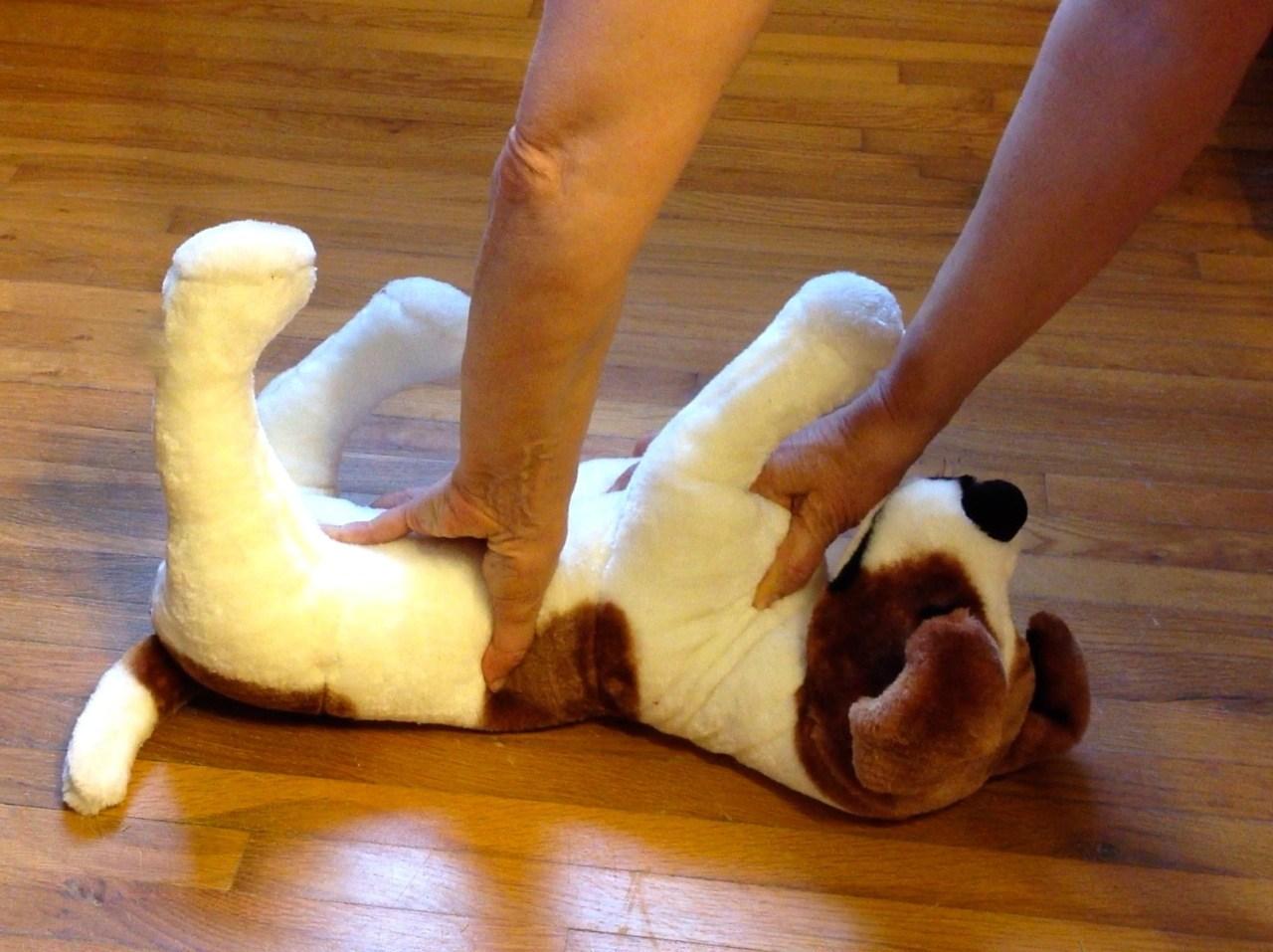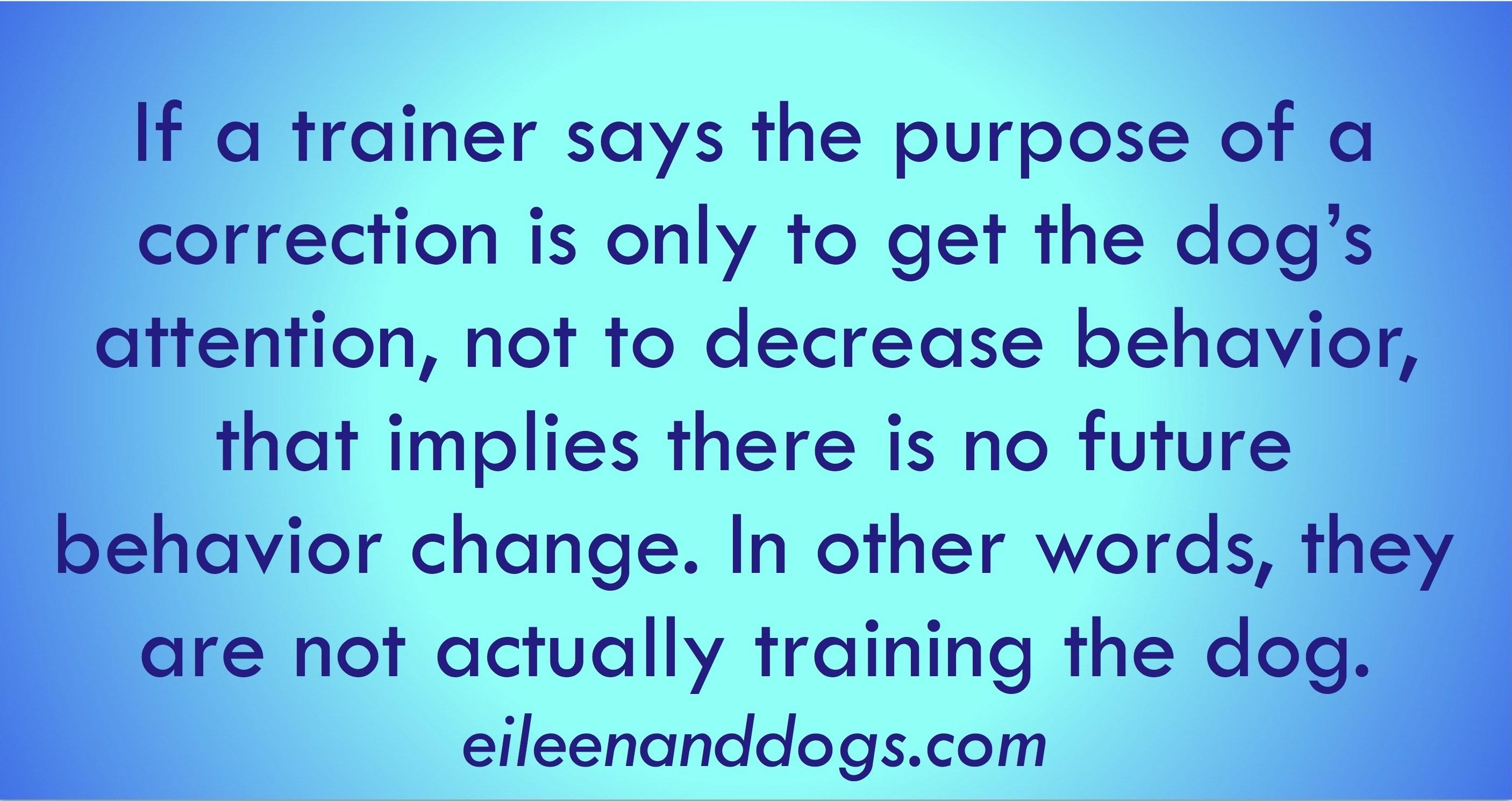Corrections Are Punishment (If They Work)
Correction is a term used in certain segments of the dog training world. It commonly applies to jerking the dog’s leash (also called a “leash correction). Sometimes “correction” refers to other physical things people might do to a dog.
Trainers who use corrections do such things when a dog is performing an undesirable behavior. For example, they will perform a “leash correction” when a dog is pulling on the leash, is in the wrong position, or is not focused on the handler. The magnitude of a leash correction can range from a twitch of the leash to jerking hard enough to lift the dog partially off the ground or knock him off balance.
Corrections are intended to decrease an undesirable behavior. You never hear anyone say, “My dog was doing a gorgeous job of heeling so I gave him a correction.” You won’t hear “My dog behaved perfectly when the guests were here so I gave her a correction.”
You might hear a trainer say they gave a correction “to get the dog’s attention.” That implies the dog was not paying attention. The trainer wants to decrease sniffing, pulling, fixating on squirrels, or whatever the dog was doing instead of paying attention.
Punishment
In behavior science, what do we call a learning process in which a behavior decreases? Punishment.
There are two types of punishment. One is the removal of something appetitive (desirable), as a consequence of a behavior. An example would be holding out a treat near the dog while he is supposed to be maintaining a position. If the dog moved out of position to get it, the handler would pull the treat back out of the dog’s reach. This would constitute punishment if the behavior of moving out of position decreased in the future.
The other type of punishment is the addition of an aversive stimulus as a consequence of the dog’s behavior. An aversive stimulus is something the dog will work to avoid if they can. An example of this type of punishment would be stepping on the dog’s back foot whenever he tried to jump on you, if in the future the behavior of jumping on you decreased. (I am not recommending this technique. There are humane and effective ways to train dogs not to jump on people.)
Positive punishment, as this latter type is called, need not be obviously harsh. It need only be effective. I used to have a dog who would leave the room when I coughed. She hated that sound. (Poor dog; I have asthma.) I could probably have used coughing as a punishing stimulus.
Another typical example of positive punishment is…jerking on the leash. A.k.a a leash correction. If your dog moves out of position (undesirable behavior) and you jerk on the leash (added stimulus) and moving out of position decreases, that behavior has been punished.
Defining Words to Suit One’s Purpose
Why then, does the segment of the dog training world that employs corrections often deny that they constitute punishment? You can read this myth in a thousand articles online. You can hear it from ten thousand trainers. And it will be stated in countless beginner obedience classes. Here is a quote from a well known and successful trainer:
The purpose of a correction is to get a behavior change. It’s not to punish a dog.
Wait, what? In behavior science, the definition of punishment is about behavior change.
The reasons for avoiding the use of the word “punishment” are pretty obvious. In a world where positive reinforcement-based training is becoming more well known, many potential clients would not like the idea that a trainer may hurt their dog or instruct them to do so. So trainers who do use positive punishment often call it something else.
Many also use the word “punishment,” but they use the lay definition of the word instead of the behavior science definition. That way they can claim not to use it. The lay definition is associated with retribution and cruelty. Many such trainers use the word “punishment” to mean doing something harsh to the dog in a fit of emotion, and state that they don’t believe in doing that. They reserve the word correction to mean something planned, deliberate, and by implication less severe. And they often call it “communication” or “getting the dog’s attention” or some other benign-sounding phrase.
Defining “Correction” This Way Is a Red Flag
People are free to use different definitions of words. Heck, the retribution definition of punishment is probably the first in the dictionary. But if you choose a trainer who uses corrections and claims they aren’t punishment, you can know that one of two things is true.
- This person is ignorant of the correct terminology used in the science of behavior, even though they are claiming professional expertise and taking money for changing behavior. Or:
- This person is using an idiosyncratic definition on purpose. Whatever their explanation is for this, the effect is to mask what they are actually doing to dogs. They are minimizing the fact that they are startling, hurting, or causing some kind of discomfort to the dog. They are avoiding transparency.
I realize there is a wide spectrum of aversive techniques for training dogs. Some are harsher than others. If I used positive punishment, I, too, would want to distinguish myself from those who used more violent methods than I did. But there’s a more honest solution to that problem. The solution is to be specific and transparent about what one does. Such a trainer could say, “I use punishment in the form of jerking on the collar or scruffing dogs, but I don’t ‘helicopter’ dogs, hit them with plastic bats, or kick them.”
But that last sentence demonstrates a good reason why people who use any aversives may not want to be specific. Even the mention of more violent ways to train dogs is going to be off-putting to much of the general public. How much easier and benign sounding it is to say, “I use corrections, but not punishment.”
When Corrections Aren’t Punishment
There are situations where “corrections” aren’t punishment. And that is when they don’t work to decrease behavior. And that does happen quite often. So I suppose we could add a #3 above. If someone says that corrections aren’t punishment, it could be true if their methods don’t work to reduce behavior over time. That would also be a good reason not to let that person work with your dog.
I Use Punishment
I use negative punishment. This is the type where you remove something desirable when the dog performs an unwanted behavior. You do this with the intent of decreasing (punishing) the behavior. This method can be very effective in clarifying to a dog what behavior works and what behavior doesn’t work. But I try not to overuse it. There are some situations where it is unpleasant for the dog, even though it doesn’t employ an aversive stimulus. I’d rather train a strong behavior to begin with, using positive reinforcement, than be pulling away cookies, toys, or attention frequently. Also, with several common applications of negative punishment, positive punishment can easily creep in. I do not knowingly perform positive punishment, nor do I ever design a training plan to include it.
I just applied the word punishment to my own training and explained the ways I might use it. So if I can use the word…how about you folks out there who use “corrections”?
Copyright 2018 Eileen Anderson

Source: https://eileenanddogs.com/2018/08/28/corrections-are-punishment/



